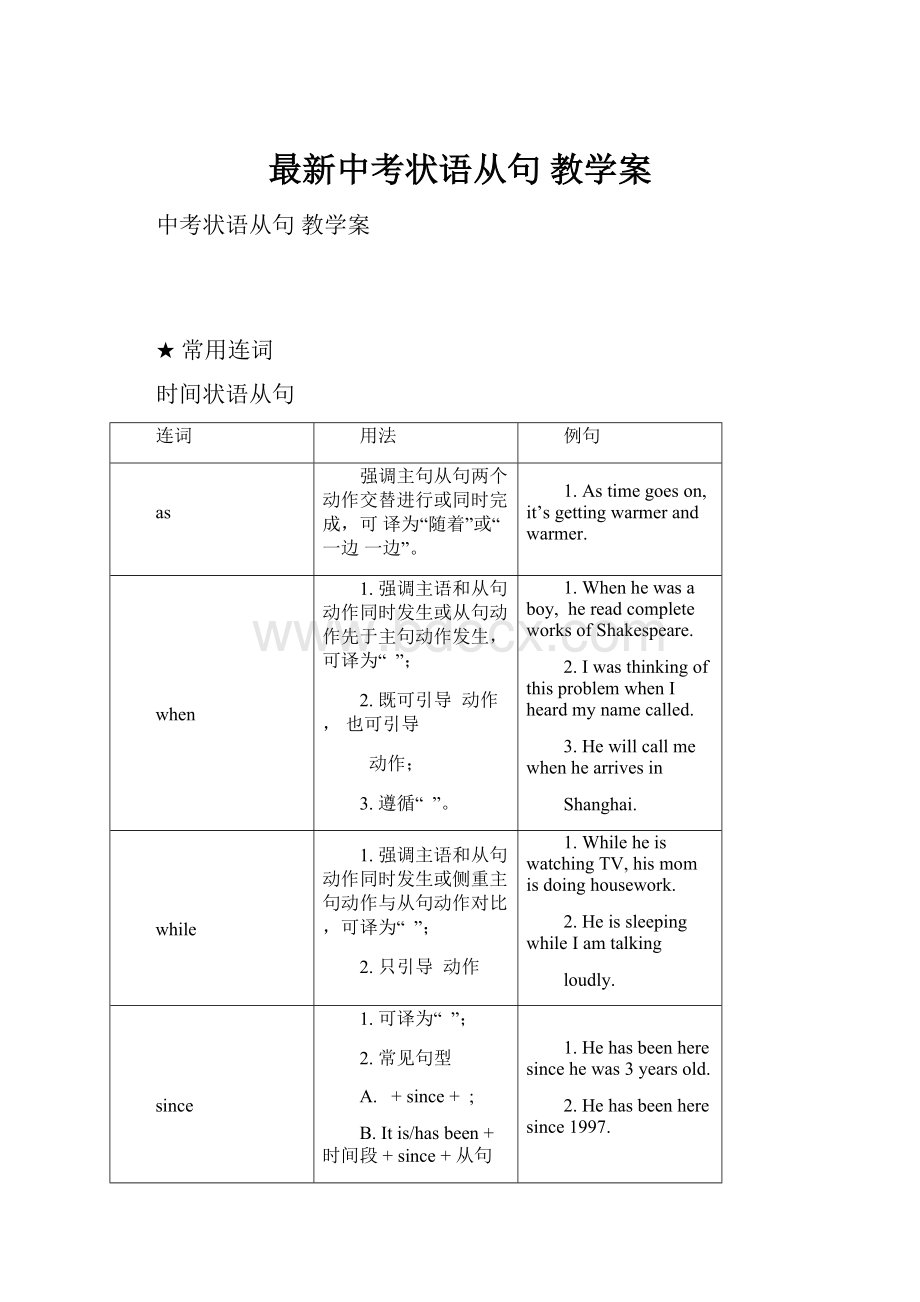最新中考状语从句 教学案.docx
《最新中考状语从句 教学案.docx》由会员分享,可在线阅读,更多相关《最新中考状语从句 教学案.docx(21页珍藏版)》请在冰豆网上搜索。

最新中考状语从句教学案
中考状语从句教学案
★常用连词
时间状语从句
连词
用法
例句
as
强调主句从句两个动作交替进行或同时完成,可译为“随着”或“一边一边”。
1.Astimegoeson,it’sgettingwarmerandwarmer.
when
1.强调主语和从句动作同时发生或从句动作先于主句动作发生,可译为“”;
2.既可引导动作,也可引导
动作;
3.遵循“”。
1.Whenhewasaboy,hereadcompleteworksofShakespeare.
2.IwasthinkingofthisproblemwhenIheardmynamecalled.
3.Hewillcallmewhenhearrivesin
Shanghai.
while
1.强调主语和从句动作同时发生或侧重主句动作与从句动作对比,可译为“”;
2.只引导动作
1.WhileheiswatchingTV,hismomisdoinghousework.
2.HeissleepingwhileIamtalking
loudly.
since
1.可译为“”;
2.常见句型
A.+since+;
B.Itis/hasbeen+时间段+since+从句
(从句用,句意为自从有多久)
1.Hehasbeenheresincehewas3yearsold.
2.Hehasbeenheresince1997.
3.Itis/hasbeenthreeyearssincethewarbrokeout.
till/until
1.一般情况下两者可以互换,但
不可以放句首,
可以;
2.遵循“”;
3.not......until......可译为。
1.Hewon’tgotobedtill/untillshe
returns.
2.UntilyoutoldmeIhadnoideaofit.
3.Ididn’thaveanyideaofituntilyoutoldme.
before
1.可译为;
2.常见句型
A.Itwillbe+时间段+before+从句
(句意为过了多久才)
B.Itwon’tbe+时间段+before+从句
(句意为没过多久就)
1.Wehadn’trunamilebeforehefelttired.
2.ItwillbehalfayearbeforeIcomeback.
3.Itwon’tbehalfayearbeforeIcome
back.
after
1.可译为。
1.Hereadsomeinterestingbooksafter
hefinishedhomework.
assoonas
1.可译为;
2.遵循“”。
1.IwillcallyouassoonasIarrivein
Beijing.
bythetime
1.可译为;
2.时态
A.从句为一般过去时,主句为;
B.从句为一般现在时,主句为;
1.Bythetimeyoucameback,Ihadfinishedthisbook.
2.Bythetimeyoucomeheretomorrow,
Iwillhavefinishedthiswork.
☆常用连词
地点状语从句
连词
用法
例句
where/wherever
1.where可译为;wherever可译为;
2.即可指具体地点,又可指抽象地点。
1.Weshouldgowhereeveryoneneedshelp.
2.Youarefreetogowhereveryou
like.
☆地点状语从句与定语从句的区别
1.where引导状语从句直接修饰;
2.
在定语从句中where作为关系副词要跟在后。
例子:
Gobackwhereyoucamefrom.()
Gobacktothevillagewhereyoucame.()
★常见连词
原因状语从句
连词
用法
例句
because
1.because表示直接原因,语气,最适合回答引导的疑问句;
2.becauseof+;
3.because和so不可同时出现在一个句子里。
1.---Whydidyouwenttherebybus?
---Wewentbybusbecauseitwascheaper.
2.Hecan’tgotoschoolbecauseof
hisillness.
since
1.since语气,表示大家都知道的原因或事实,意为“既然”;
2.Sincethat和since意义相似,that可省去。
1.Sinceyouarefreetoday,youhadbetterhelpmewithmymaths.
2.Now(that)everyoneishere,let’s
beginourdiscussion.
as
1.as语气最弱,往往是不明显的原因,只是对结果
的附带说明。
1.Iwenttobedearly,asIwas
exhausted.
for
1.for引导的并列句只能放于主句后并且必须用
将其与主句隔开。
2.for只提供一些辅助性的补充说明。
1.Heseldomgoesoutnow,forheisveryold.
2.Hecouldnothaveseenme,forI
wasnotthere.
★常见连词
条件状语从句
连词
用法
例句
if
1.遵循;
2.用于表示客观真理时,主从句都用
;
1.Wewillstopplayingifitrains.
2.Ifyoufreezewater,itturnsintoice.
unless
1.可译为;
2.相当于
1.Theconcertwillbeheldasschedule
unlessthereisatyphoon.
=Theconcertwillbeheldasschedule
ifthereisnotatyphoon.
solongas
/aslongas
1.可译为
1.Idon’tcareso/aslongasshelets
mebewithherson.
★易错点
1.可同时引导宾语从句和条件状语从句
从句
释义
时态
条件状语从句
宾语从句
2.祈使句,+简单句。
祈使句相当于一个由if引导的条件状语从句:
用引导的简单句常表示一个较好的结果,用引导的简单句常表示一个不愉快或不理想的结果。
★常见连词
结果状语从句
连词
用法
例句
sothat
1.可译为;
2.句型:
A.;
B.;
C.;
D.
1.Lilyissolovelythateveryonelovesher.
2.Lilyworkssohardthatshepassestheexam.
3.Lilyissolovelyagirlthateveryonelovesher.
4.Lilyreadssomanybooksthatshepassestheexam.
suchthat
1.可译为;
2.句型:
A.
1.Lilyissuchalovelygirlthateveryonelovesher.
2.Sheissuchalittlegirlthatshecan’tgotoschool.
练习:
1.Theboyisyoungthathecan'tgotoschool.
2.Heisayoungboythathecan'tgotoschool.
3.TherearemanypeopleonthestreetthatIdon’twanttogoout.
4.Itisalittlemicethatwecan’tcatchit.
5.Sheisniceagirlthateveryonelovesher.
6.Sheisanicegirlthateveryonelovesher.
★常见连词
目的状语从句
连词
用法
例句
sothat
/inorderthat
1.可译为;
2.可放句首;
不可放句首
3.从句常与情态动词can,may,could,must,might等连用
1.Youmustspeakloudersothat/inorderthat
youcanbeheardbyall.
2.Inorderthatwemightseethesunrise,westartedforthepeakearly.
forfearthat
/incase
1.可译为
1.Hewrotethenamedownforfearthatheshouldforgetit.
2.Bettertakemoreclothesincasetheweather
iscold.
★inorderto&soasto
1.inorderto/soasto+。
此时inorderto后面加的被称作目的状语。
例句:
Hegotupearlyinordertotakethefirstbus.
=Hegotupearlyinorderthathecouldtakethefirstbus.
2.inorderto和soasto区别:
可放句首;不可放句首。
例句:
Hegotupearlyinorderto/soastotakethefirstbus.
Inordertotakethefirstbus,hegotupearly.
★常见连词
让步状语从句
连词
用法
例句
though/although
1.可译为;
2.一般可,但都不能与
连用;
3.可用在句末,表示“可是,然而”
1.Although/Thoughhewasexhausted,hekeptonworking.
2.Hesaidhewouldcome;hedidn’t,
though.
eventhough
/evenif
1.可译为;
2.可以与虚拟语气连用
1.Eventhough/ifitisraining,Iwillgo.
2.Eventhough/ifIwerebusy,Iwould
go.
as
1.可译为;
2.引导状语从句需要
(though可倒装也可不倒装)
1.Happyastheywere,therewassomethingwrong.
2.MuchasIlikeit,Iwon’tbuyit.
3.Childasheis,heknowsalot.
1.Nomatterwhoyouare,youmust
nomatter+疑问词
/疑问词+ever
1.可译为;
2.不存在;
3.nomatterhow/however引导的让步状语从句中,会提前到主语前
obeyrules.
=Whoeveryouare,youmustobeyrules.
2.Nomatterhowoldyouare,youshouldkeepstudying.
3.Howeverhardheworks,hecouldn’t
passtheexam.
☆常见连词
方式状语从句
连词
用法
例句
as
1.可译为
1.Doasyouaretoldto,oryou’llbefined.
asthough
/asif
1.可译为
1.IfeelasifIhaveafever.
一、英语阅读理解专项练习试卷
1.阅读理解
OnedayIgotinataxi,andweleftfortheairport.Weweredrivingintherightlane(车道)when,suddenly,ablackcarjumpedoutofaparkingspacerightinfrontofus.Mytaxidriverstoppedhiscaratonce.Thetire(轮胎)madeaveryloudnoise,andattheverylastmomentourcarstoppedjustoneinchfromthebackoftheothercar.
Iwasfrightened.ButthenIcouldn'tbelievewhathappenednext.Thedriveroftheothercar,theguywhoalmostcausedabigaccident,turnedhisheadandstartedyellingatus.Icouldn'tbelieveit!
Butmytaxidriverjustsmiledattheguy.SoIasked,“Whydidyoujustdothat?
Thisguyalmostsentustohospital.”
ThisiswhenmytaxidrivertaughtmywhatInowcall,“TheLawoftheRubbushTruck(垃圾车法则).”Heexplainedthatmanypeoplearelikerubbishtrucks.Theyrunaroundfullofrubbish,fullofangerandfullofbadfeelings.Astheirrubbishpilesup,theylookforaplacetothrowitawayandsometimesthey'llthrowitatyou.Don'ttakeitpersonally.Justsmile,wishthemwell,andmoveon.Don'ttaketheirrubbishandspreadittootherpeopleatwork,athomeoronthestreets.
Successfulpeopleneverletrubbishtruckschangetheirmoods.Lifeistooshorttowakeupinthemorningwithregrets,solovethosewholoveyouandpray(祈祷)forthosewhodon't.
(1)WhichofthefollowingisNOTtrueaccordingtothefirstparagraph?
A. Thewriterwenttotheairportbytaxithatday.
B. Thetaxidriverstoppedhiscarintime.
C. Theblackcarjumpedoutandcrashedintothetaxi.
D. Acaraccidentnearlyhappenedonthewriter'swaytotheairport.
(2)Theunderlinedwordyellinginthesecondparagraphmeans inChinese.
A. 道歉 B. 傻笑 C. 吼叫 D. 告别
(3)Whydidtheguygetangrysoeasily?
A. Becausehewasinabadmood.
B. Becausehiscarwasfullofrubbish.
C. Becausehewasbadlyhurtbythetaxi.
D. Becausethetaxidriverdidn'tsaysorrytohim.
(4)Fromthepassage,wecantellthatthetaxidriveris_______.
A. sillyanddishonest
B. wiseandfriendly
C. helpfulbutnervous D. modestbutimpatient
(5)Whatdoesthepassagemainlytellus?
A. Fightwithpeoplelikerubbishtrucks.
B. Makefriendswithpeoplelikerubbishtrucks.
C. Haveaquarrelwithpeoplelikerubbishtrucks.
D. Don'tletrubbishtruckschangeourmoods.
【答案】
(1)C
(2)C
(3)A
(4)B
(5)D
【解析】【分析】本文叙述了作者乘坐出租车时发生的事情,通过出租车司机的一番话,阐明一个道理:
记住美好的,忘却不愉快的,专注重要的;对待生活的态度决定生活的状态。
(1)C推理判断题。
题意:
根据第一段,下面哪一个不对?
A.Thewriterwenttotheairportbytaxithatday.那一天作者坐出租车去的机场;B.Thetaxidriverstoppedhiscarintime.出租车司机及时停了车;C.Theblackcarjumpedoutandcrashedintothetaxi.黑色的小车跳出来撞向出租车;D.Acaraccidentnearlyhappenedonthewriter'swaytotheairport.在作者去机场的路上差不多发生了一次交通事故。
根据第一段:
Weweredrivingintherightlane(车道)when,suddenly,ablackcarjumpedoutofaparkingspacerightinfrontofus.Mytaxidriverstoppedhiscaratonce.可知黑色的小车冲出来,但是没有撞着出租车。
故选C。
(2)C词义猜测题。
题意:
第二段中,有下划线的yelling的汉语意思是什么?
A.道歉;B.傻笑;C.吼叫;D.告别。
句意:
Thedriveroftheothercar,theguywhoalmostcausedabigaccident,turnedhisheadandstartedyellingatus.另一辆车的司机,造成事故的家伙,转过头来开始对我们yelling。
从语境可以推测出其含义是吼叫,故选C。
(3)A推理判断题。
题意:
为什么这个家伙那么容易生气?
A.Becausehewasinabadmood.因为他情绪很差;B.Becausehiscarwasfullofrubbish.因为他车里满是垃圾;C.Becausehewasbadlyhurtbythetaxi.因为他被出租车重重地伤着了;D.Becausethetaxidriverdidn'tsaysorrytohim.因为出租车司机没有给他道歉。
根据作者后面的讲述可以知道:
当人们情绪不好时需要找时间、地点发泄,而出租车司机不愿意把人们的这些垃圾传播开去。
故选A。
(4)B推理判断题。
题意:
从短文中,我们可以说出租车司机是怎样的一个人?
A.sillyanddishonest傻而且不诚实;B.wiseandfriendly聪明,友好;C.helpfulbutnervous有帮助的,紧张不安的;D.modestbutimpatient现代但是没有耐心。
文中的出租车司机面对别人的怒气,面带微笑,不愿把别人的垃圾情绪传播出去,说明他聪明,待人友好。
故选B。
(5)D主旨推断题。
题意:
短文主要告诉我